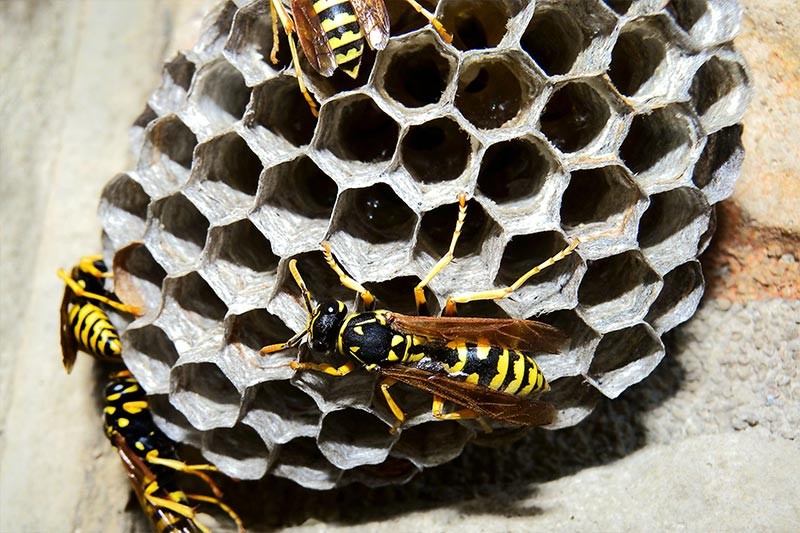
Have you ever thought of performing wasp control Vancouver yourself? Predatory insects belonging to the suborder Apocrita and order Hymenoptera are called wasps. Wasps, belonging to the suborder Apocrita, do not sting potential predators like ants and bees do. They have a smooth exoskeleton, short-haired legs, and wings, giving them a sleek appearance. Plus, they do have antennae and sections of their mouths for biting. There are around 10,000 different species of wasps. Most of them fall into the category of solitary wasps, although there are also social wasps among them. Social wasps belong to the family Vespidae. But the solitary wasps are classified under the superfamilies Chrysidoidea, Apoidea, and Vespoidea. Let us now examine the wasp life cycle to gain better knowledge.
During the winter, the fertilized female wasp queen hibernates. When their hibernation period ends, the queen wasps begin constructing a nest for themselves. The queen wasp spits the remaining wood after she has chewed it and utilized it to build her home. Well, the wasp queen constructs tiny cells and deposits 200–300 eggs daily. Wasps build new nests each year and do not reuse their existing ones. As a result, we do not witness active wasp nests throughout the spring. Wasps help in plant pollination and rely on nectar from flowers and plants.
The wasps are now constructing their colonies and nests. Well, the wasp uses wood fragments it have chewed and combined with saliva to make a paste to build its nest. The queen wasp uses her sperm reserves to fertilize the eggs she lays inside the nest. Thus, the nest grows larger as new wasps join the colony during this phase. Emerging sterile wasps assist in constructing the nest. This is the moment when the need of performing hornet control Vancouver comes into your way.
The queen lays her final eggs when the number of wasps she gives birth to rises. These eggs develop into fertile wasp males and females. After leaving the nest, the male wasps mate and eventually perish. After mating, the female wasps hibernate with the sperms to build a new nest the following summer. Thus, the process of reproduction starts over. The fertilized female wasps look for a different place to hibernate as winter draws near. Well, the giant nest is at this stage, and all the larvae have already pupated. This larvae's sugar solution provides food for the worker wasps. The worker wasps are left without food once all the larvae have pupated, so they leave the nest to hunt for other food sources. Most of the food sources run out as winter draws near, and the newly hibernating queen wasps perish. The entire cycle occurs once more in the spring.
Following a thorough inspection, it's important to do regular maintenance for wasp removal Vancouver in any area of your house that appears suitable for a hive. Try your best to seal off or block any openings that wasps might enter, repair and seal ageing decks or fences, restore any damaged siding, and regularly trim your plants and grass to a clean appearance.
Hummingbird feeders and nectar-rich blooms should be kept to a minimum. You should place them away from common areas such as your patio or deck if you intend to landscape in the spring. This will help you to reduce the population of bees, hornets or wasps trying to attack your property all the time.
When putting garbage bags inside a trash can, make sure they are firmly tied. Look for trash cans with lids that fit tightly. Ensure that all garbage goes into the appropriate container and that spills are cleaned immediately when you have outside gatherings with food and beverages. Wasps are looking for full tummies, so any beverage or food scraps left around could draw their attention.
Calling the experts of pest control as soon as possible is essential for eliminating the severe bed bug infestations, such as those caused by houseflies, spiders, ants, or caterpillars. When wasps are out searching for food, an excess of these insects can attract their interest, turning your yard into the main wasp colony's nesting area.
What distinguishes wasps from bees?
Wasps have a pointed waist and lower abdomen or petiole. The thorax and abdomen are divided by the petiole. When it comes to behavior, wasps are more hostile than bees. Additionally, wasps have multiple stinging abilities, while bees only have one.
What do wasps consume?
Wasps consume sugar, insects, fruits, and nectar.
What occurs when a wasp is killed?
Do not kill a wasp if you come across one and have plans to do so. A chemical released by a dead wasp alerts the other clan members of its presence. It is advisable to leave wasps alone at this stage because the other wasps may also become more aggressive.
Eliminating wasps with specialized service of ASM Pest Control
Even though wasp nests and populations can disappear on their own, ignoring a nest close to your house or family could be harmful. To make sure that there are no such wasps on your property, just arrange a wasp inspection with the services of ASM Pest Control. To safely and successfully perform bee control, our team of qualified and professional specialists uses a proper integrated pest management strategy.
Conclusion
Of all insects, wasps are infamous for their ability to sting humans. However, as most wasps are solitary, they are not venomous. Some species of wasps feed on almost all nuisance insects. Because wasps effectively reduce pest pollution, wasp infestation is diminished in many agricultural businesses.